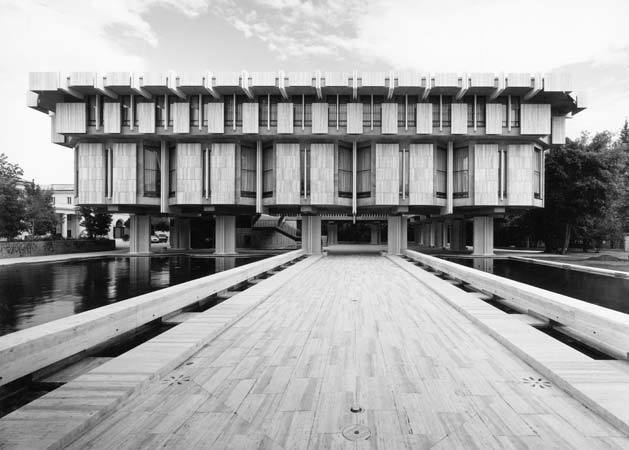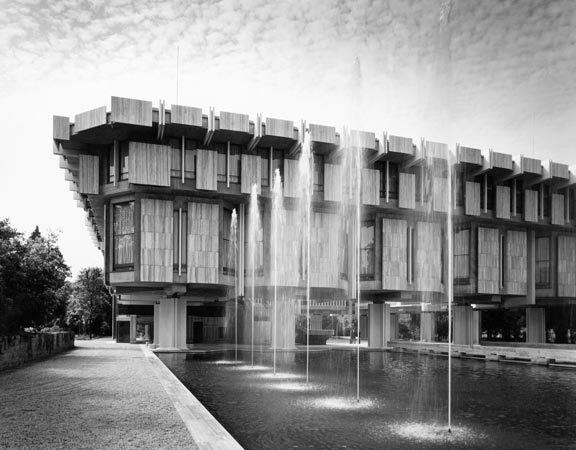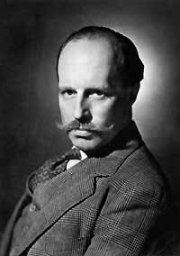Nationality United Kingdom Parents Urwin Archibald Spence Role Architect | Name Basil Spence Occupation Architect | |
 | ||
Born 13 August 1907 ( 1907-08-13 ) Bombay, India Practice Basil Spence & Partners Died November 19, 1976, Yaxley, United Kingdom Spouse Joan Ferris (m. 1934–1976) Books New Buildings in Old Cities: The Second Gwilym James Memorial Lecture of the University of Southampton, Delivered at the University on the 23d Feb. 1973 Structures | ||
Sir basil spence
Sir Basil Urwin Spence, OM, OBE, RA (13 August 1907 – 19 November 1976) was a Scottish architect, most notably associated with Coventry Cathedral in England and the Beehive in New Zealand, but also responsible for numerous other buildings in the Modernist/Brutalist style.
Contents
- Sir basil spence
- Sir Basil Spence 1970 1979
- Training
- Early career
- Army service
- Post war career
- Coventry Cathedral
- Later work
- Assessment
- List of projects
- References

Sir Basil Spence (1970-1979)
Training

Spence was born in Bombay, India, the son of Urwin Archibald Spence, an assayer with the Royal Mint. He was educated at the John Connon School, operated by the Bombay Scottish Education Society, and was then sent back to Scotland to attend George Watson's College in Edinburgh from 1919–1925. He enrolled at Edinburgh College of Art (ECA) in 1925, studying architecture, where he secured a maintenance scholarship on the strength of the "unusual brilliance" of his work. He won several prizes at the college, and meanwhile carried out paid work drawing architectural perspectives for practising architects including Leslie Grahame-Thomson and Reginald Fairlie.

In 1929–1930 he spent a year as an assistant, along with William Kininmonth, in the London office of Sir Edwin Lutyens, whose work was to have a profound influence on Spence's style, where he worked on designs for the Viceroy's House in New Delhi, India. While in London he attended evening classes at the Bartlett School of Architecture under A. E. Richardson. Returning to ECA in 1930 for his final year of studies, he was appointed a junior lecturer, despite the fact that he was still a student. He continued to teach at ECA until 1939.
Early career

After graduating in 1931, Kininmonth and Spence set up in practice together, based in a room within the office of Rowand Anderson & Paul (at that time having Arthur Forman Balfour Paul as sole partner), in Rutland Square, Edinburgh. The practice was founded on two residential commissions which Kininmonth had obtained that year. Spence also received commissions to illustrate other architect's work, including the Southside Garage, on Causewayside, Edinburgh, in an Art Deco style (although credited to Spence his name appears nowhere on the official warrant drawings and only appears as a signature on the artist's perspective).

In 1934 Spence married, and the Kininmonth & Spence practice merged with Rowand Anderson & Paul. Balfour Paul died in 1938, leaving Kininmonth and Spence in charge of the renamed Rowand Anderson & Paul & Partners. Spence's work was now concentrated on exhibition design, including three pavilions for the 1938 Empire Exhibition in Glasgow, and country houses. The first two of these, Broughton Place at Broughton near Biggar, and Quothquhan in Lanarkshire, were executed in traditional Scottish styles at the client's request. The third was entirely modern. Gribloch was designed for John Colville, grandson of the founder of Colville's Iron Works, and his American wife. It was designed in a modernist Regency style, with assistance from Perry Duncan, an American architect hired by the Colvilles when Spence was too busy with exhibition work to progress the project.
Army service

In 1939, Spence was commissioned as a second lieutenant into the Camouflage Training and Development Centre of the British Army. He was initially based at Farnham in Surrey, and took part in the D-Day landings in 1944. He was demobilised in September 1945, having reached the rank of major and been mentioned in despatches twice.
Post-war career
Spence returned to Rowand Anderson & Paul & Partners briefly, before setting up his own practice, Basil Spence & Partners, with Bruce Robertson. He was awarded an OBE in 1948 for his work in exhibition design, work which he continued with the Sea and Ships Pavilion for the 1951 Festival of Britain. That year he opened a London office, moving there permanently from 1953. A second office was opened in 1956 at Canonbury, which became the creative hub of the practice. Spence was External Professor of Architecture at the University of Leeds from 1955 to 1957 and from 1958 to 1960 he was the President of the Royal Institute of British Architects.
Coventry Cathedral
On 14 November 1940, Coventry's Anglican Cathedral was extensively damaged by German bombing, a year into World War II.
In 1944, Sir Giles Gilbert Scott submitted a design proposal to rebuild the cathedral but this was rejected by the Royal Fine Arts Commission. In 1950, a competition was launched to find the most suitable design from a Commonwealth of Nations architect. Over 200 entries were received, and Spence's radical design was chosen. Work began in 1956 and the structure was completed in 1962. Spence was knighted in 1960 for his work at Coventry, while the cathedral was still being built.
On 23 February 2012 the Royal Mail released a stamp featuring Coventry Cathedral as part of its "Britons of Distinction" series.
Later work
In 1959 Spence secured two important commissions, for the British Embassy in Rome (completed 1971), and for the Hyde Park Cavalry Barracks in London (completed 1970). He was also responsible for designing the high-rise Hutchesontown C housing in Glasgow. These were intended to replace the notorious slum tenements in the Gorbals area of the city. A combination of social deprivation and exclusion in the relevant areas, coupled to poor execution of his designs meant that the developments created as many problems as they solved, and led to their demolition in 1993. He was also responsible for modernist buildings on The Canongate in Edinburgh, opposite the new Scottish Parliament and in view of Holyrood Palace. This area is named Brown's Close and was listed in 2008. Other work in the 1960s included the concept design for the executive wing of the New Zealand Parliament Buildings in Wellington, nicknamed "The Beehive", Edinburgh University Library, and Abbotsinch Airport (now Glasgow Airport). In 1960, Spence designed Mortonhall Crematorium in Edinburgh's Braid Hills area (based on the same angled fin concept as found at Coventry Cathedral). He also designed Trawsfynydd nuclear power station, which was unveiled in Snowdonia, north Wales, in 1964.
Also in 1964, with support from the Nuffield Foundation, the University of Southampton built a theatre on its campus for the people of Southampton. Nuffield Southampton Theatres was built by Sir Basil Spence, OM RA, who worked closely with Sir Richard Southern as consultant for the interior design and layout of the theatre.
The Spence practice was rearranged in 1964, with the Canonbury office being renamed Sir Basil Spence OM RA, and the second London office Spence Bonnington & Collins. The Edinburgh office was also renamed for its partners, Spence Glover & Ferguson. From 1961 to 1968, Spence was Professor of Architecture at the Royal Academy. Through the 1970s, Spence continued to work on public and private commissions, universities and offices including Aston University Library and Management Centre. His last work was for an unexecuted cultural centre for Bahrain, which he worked on during illness in 1976. Some of his final commissions were built after his death; for example, his design for the new Glasgow Royal Infirmary was completed in 1981.
Spence died in November 1976 at his home at Yaxley, Suffolk and was buried at nearby Thornham Parva. His practice – Spence, Ferguson and Glover continued until 1992 before being disbanded.
Assessment
In 2006 he was the subject of a BBC Scotland documentary, Rebuilding Basil Spence, which revised his place in 20th-century British architecture and asked why he had been for so long overlooked. In 1993 Spence's Hutchesontown C complex was listed by the international conservation organisation DoCoMoMo as one of Scotland's sixty key monuments of the post-war years, in the same year as it was demolished.
In August 2010 English Heritage recommended that the Spence-designed Sydenham School be given Grade II listed status: the building was due to be demolished to make way for a new building. However the government's decision was that the school was not of sufficient merit to warrant listing.
